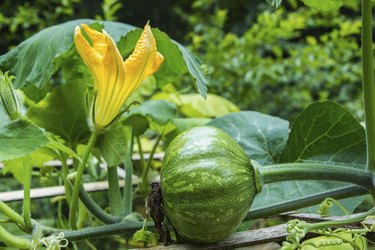
Kabocha pumpkins (Cucurbita maxima, Cucurbita moschata x maxima) deliver sweetness and nutty texture for minimal labor. Also known as Japanese pumpkins, kabocha squash varieties need the same simple care as their close relatives, common pumpkins and winter squash (Cucurbita maxima). Even small gardens can grow kabochas with a bit of planning. It starts with sun and space, and it ends with delicious harvests.
Site Requirements
Video of the Day
To reach their full potential, kabocha squashes need full sun, good circulation and room to grow. Provide the vines with at least six to eight hours of full, direct sun each day and space to reach 10 to 15 feet in length. Allow kabochas to sprawl on the ground or let their tendrils climb a sturdy trellis or other support. For horizontal growing, space kabocha plants 3 feet apart in rows separated by 5 to 6 feet. If growing kabochas vertically, anchor your support firmly. Use soft plant ties to provide stems with added support once your kabocha fruits begin to grow.
Video of the Day
Soil and Nutrition
Kabochas adapt well to different soil types and pH levels, but optimal harvests come in rich, well-drained, slightly acidic soil with pH near 6.0 to 6.5. Incorporate 3 to 4 inches of organic compost into the soil before planting to improve drainage and moisture retention. No other fertilizers are needed upfront, but a nitrogen boost helps midseason; apply 1/2 cup of 46-0-0 fertilizer alongside your kabocha vines for each 25 row feet, and water the fertilizer in well. Wear protective clothing, including gloves and safety eyewear, and avoid contact with exposed skin. Wash well with soap and water after handling fertilizers.
Moisture and Maintenance
Sweet, meaty kabocha squashes need regular moisture throughout their growing season. Supplement rainfall so your vines receive 1 inch of water each week. In average garden soil, water deeply once per week. Kabochas in sandy soils need more frequent waterings with less water per session. Moisten the entire root zone when you water. Kabocha leaves may droop in midday sun and heat, but well-tended vines recover in the cool of the afternoon. Plants grown on supports may need extra water to compensate for sun exposure. Be gentle when weeding or cultivating around kabocha vines; they have shallow roots.
Pollination and Harvest
Kabocha squash vines have distinct male and female flowers on each plant. Bees do the bulk of kabocha pollination, so avoid garden chemicals that may harm them. Hand pollination improves the yield and quality of kabocha fruit. Simply transfer pollen from male flowers to female flowers on the morning they open. Female blooms have tiny kabochas-in-waiting right below their blooms; male flowers have long, simple stems. Kabocha stems turn hard and corky at maturity, and green-skinned kabocha varieties shift from bright to dull. Sweetness develops on the vine, not in storage, so let kabochas mature fully before you harvest.